|
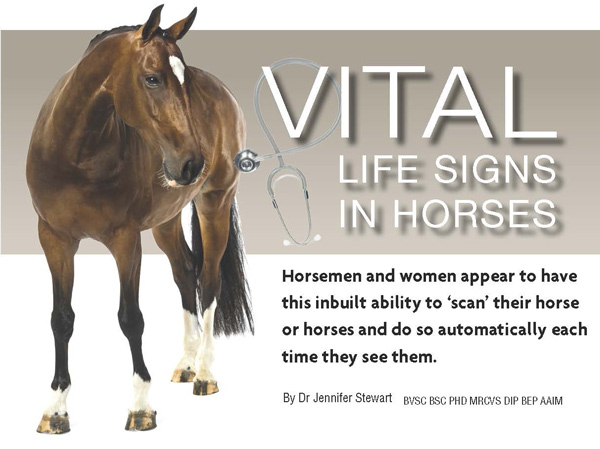
We all do it, and in most cases it is without conscious thought. Even while chatting with someone you can see a horse owner’s eyes running over their horse and they notice anything different.
However, it is often the changes that we can’t see that are more important and recognising and taking steps to check when something is ‘not quite right’ is an important aspect of horse management.
Because you are the most likely person to notice if your horse is not feeling well, knowing what’s normal for your horse’s vital signs is really worthwhile for several reasons:
• it makes it easier to detect if something’s not right;
• variations from normal can indicate pain or disease;
• they can be used to monitor responses to treatment or medications;
• they can be a signal as to what body system might be affected;
• and they will help you to alert your vet if there are any changes in what’s normal for your horse.
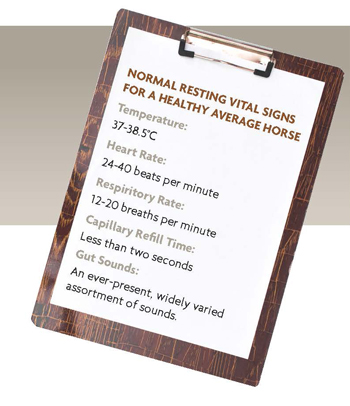 Temperature, pulse, and respiration (TPR) – the basic physiological parameters of essential bodily functions i.e. vital signs – are good to know for everyone who cares for horses. So, to recognise if your horse’s TPR values are abnormal, you first need to identify what is normal – both at rest and after exercise. And there are a few abbreviations that are good to know too! Temperature, pulse, and respiration (TPR) – the basic physiological parameters of essential bodily functions i.e. vital signs – are good to know for everyone who cares for horses. So, to recognise if your horse’s TPR values are abnormal, you first need to identify what is normal – both at rest and after exercise. And there are a few abbreviations that are good to know too!
Normal heart rate (HR) is 24-40 beats per minute (bpm), rectal temperature 37-38.5ºC and respiratory (breathing) rate (RR) 12-20 breaths per minute. But there are other vital signs that can be helpful, including the gums or mucous membranes (conjunctiva, inside nostrils), the capillary refill time (CRT), gut sounds, manure and urine frequency and water consumption. The colour of the gums should be light pink and moist, capillary refill time less than 2 seconds, intestinal sounds should be audible on both sides of the abdomen, 8-12 manures and 3-4 urinations should be passed every 24 hours and a 500kg horse drinks 20-25 litres every 24 hours. Keep in mind that although these are the normal ranges, each horse can vary a bit from the norm, which is why it is important for you to know your horse’s ‘normal’.
With a thermometer and a watch, your hands and ears, you can take vital signs. A stethoscope can help too.
TEMPERATURE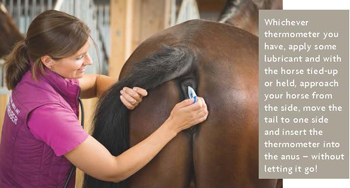
If you have a glass-mercury thermometer, tie some brightly-coloured string or tape through the end hole to help find the thermometer if it is dropped or lost. You can also put a small clip or clothes peg at the end of the string so it can be attached to the horse’s tail and left in place until the temperature can be read.
A digital thermometer requires less time for a reading and is less rigid than a glass mercury thermometer. Whichever one you have, apply some lubricant and with the horse tied-up or held, approach your horse from the side, move the tail to one side and insert the thermometer into the anus – without letting it go! Most thermometers register fairly close within a minute in the rectum. However, a period of three minutes may be more accurate.
Low temperatures may indicate a circulatory problem or extreme cold. False readings can occur if there is manure or gas sitting in the rectum so if the reading is low, walk the horse for 5-10 minutes to move the gas or manure and recheck. Temperature can be increased after exercise, with fear, pain or excitement and if there is illness or infection.
PULSE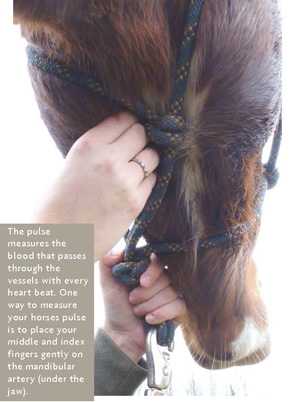
The pulse measures the blood that passes through the vessels with every heart beat. It can be measured by placing your middle and index fingers gently on the mandibular artery (under the jaw), digital (on the outside of the fetlock) or transverse facial artery (just to the side of the eye). Arteries feel like a narrow cylinder. Count the pulse for 60 seconds. Take your time with this because the pulse is slow and can be difficult to feel.
If you rush you may have been in the correct place but just not waited long enough to feel the pulse. Pulse increases with fear, pain, excitement and cardio-vascular problems. A decrease may be an electrical problem in the heart or just normal in a very fit horse.
Small ponies can have a slightly higher resting pulse rate than horses, and although the normal heart rate for most horses is 32 to 36 beats per minute, some horses have lower heart rates, 24 beats per minute, or maybe slightly higher heart rates, 40 beats per minute.
Foal heart rates vary depending on age. Newborn foals have a heart rate of between 80 to 100 beats per minute. Foals which are a few weeks to a few months of age will have heart rates of 60 to 80 beats per minute. Pulse should also be felt for quality - weak and thready, or strong. This may take some practice by feeling other horse’s pulse amplitudes over time.
HEART RATE (HR)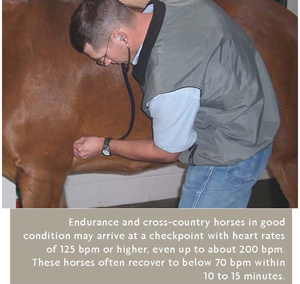
Heart rhythm can also be monitored by palpation of the heart beat and pulse. In slim animals the heart beat can be detected by placing a hand over the left lower chest just behind the elbow. To determine an accurate heart rate, the horse must be calm, cool, rested, and relaxed. Exercise, fright and hot weather can increase the heart rate andexcited and anxious horses can have elevated heart rates (> 44 bpm). Eliminating the reason for excitement and getting the horse to stand quietly usually results in the heart rate returning to normal.
An elevated heart rate, greater than 60 beats per minute, is common in horses that are uncomfortable and in pain. It is important to contact you veterinarian, especially if these horses are showing symptoms of colic, sickness, lacerations/fractures or other signs of illness. A normal horse’s heart rate will rise and fall within a minute with stimulus eg fright or something unusual, and then fall back to resting levels. An ill horse may have a heart rate from 80 to 120 beats per minute for long periods and urgent veterinary attention should be sought.
Beats and hence pulse should be regular and consistent. After exercise or during endurance rides, the heart rate recovery is important. A fit horse may have a very high heart rate when it is working hard - horses exercising very strenuously can reach heart rates of 240 to 250 bpm, but it should return to normal within 15-60 minutes after the horse has stopped working.
Endurance and cross-country horses in good condition may arrive at a checkpoint with heart rates of 125 bpm or higher, even up to about 200 bpm. These horses often recover to below 70 bpm within 10 to 15 minutes. Missed beats are common in the horse and can be of no clinical significance. However, knowing which beats are missing requires experience and should be left to the expertise of your vet. Abnormal heart rhythm, which is consistently irregular or has periods or irregularity, may be indicative of a problem, and your vet should be consulted.
RESPIRATION RATE (RR) - Breathe-in and breathe-out equals one.
To monitor respiration, it is easiest to watch the chest and the abdomen rise and fall when standing to the side and back of the horse looking forward. Count each inhalation (breathe in) and exhalation (breathe out) together as one breath (12-20). You can also listen for the RR with your stethoscope, or watch the flare of the nostrils.
RR may be a little higher in ponies (up to 20-24 breaths/minute); in foals, it will depend on their age, and after exercise RR will be increased. If it doesn’t decrease again following exercise or at rest, or there is an increase in effort to breathe, there may be a problem. RR triples when a horse walks, with exercise in hot conditions it may increase to 120 breaths per minute. However, in a fit horse the rate should decline to 40 or 50 breaths per minute within 10 or 15 minutes.
HEART RATE / RESPIRATION RATE
The ratio of heart rate to respiration rate in horses is usually about 4:1. That is, the heart beats 4 times for each breath the horse takes. If the respiration rate exceeds the heart rate, the horse has a serious problem. The horse must stop and rest until the condition corrects itself. If the condition does not correct itself, a veterinarian must be called. Pain, fever, toxicity or illness can increase RR. If a horse’s RR is above normal for no apparent reason (work, fright, or excitement for example), the horse may be ill, in pain or injured.
CAPILLARY REFILL (CRT)
The capillary refill time (CRT) measures how long it takes for the small blood vessels to refill with blood once it has been pushed out. This can be done over the gums above the front teeth by gently pressing a finger on the membrane surface to push out the local blood from the vessels (so the area turns yellowy/white). Time in seconds how long it takes for the area to become pink again. This should be less than 2 seconds. And if it is longer, note the colour of the gums and then contact your veterinarian.
INTESTINAL /GUT SOUNDS
Intestinal or gut sounds are the noises of the intestinal tract as it contracts and relaxes, moving food and faeces along. It can be hard to ascertain if these are normal without a stethoscope and lots of practice. Placing your ear to the abdomen can give an indication if the guts are moving and ‘gurgling’ as normal. Listen on each side of your horse’s abdomen, above and below the flank area. Sounds may include gurgles, rumbles, tinkling or gas and vary in frequency and loudness in different regions of the belly. You should always be able to hear sounds in all areas if using a stethoscope. Overactive movement of the guts may be heard easily standing away from the horse, but quiet sounds can be hard to hear even with a stethoscope or an ear to the abdomen. Changes in the frequency and amplitude of gut sounds can occur in a normal horse, but they may also indicate changes in gut motility, which need to be investigated.
With practice and patience some people can detect the presence of sand in the gut. According to Dr Derek Major from Agnes Banks Equine Clinic, sand in the gut can be ‘heard’ by placing the stethoscope midway between the umbilicus (belly button) and the xiphisternum (the lowest extant of the rib cage). Evocative of a gentle wave moving over a sandy beach, it takes practice to be become sufficiently accustomed to the normal burbles and squeaks to detect beneath them the soft sound of sand. And you may have to listen for several minutes before it makes itself heard.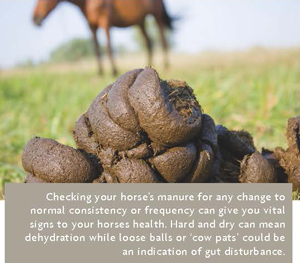
There are other vital signs that can be checked that involve daily observations. These include checking your horse’s manure for any change to normal consistency or frequency. Hard and dry can mean dehydration while loose balls or ‘cow pats’ could be an indication of gut disturbance.
For an overall hydration check you can take a pinch of skin on the horse’s neck near its shoulder. When the horse is well hydrated this will return to normal in less than a second, with older horses taking a little longer. Longer than 2-3 seconds and there is cause for concern.
Another sign that will indicate something is not right with your horse is if its breath is not ‘sweet’. If it smells ‘off’ then it could be an indication of a dental problem.
Master taking vital signs and you could greatly increase your horse’s chance of surviving a serious illness or accident, recognise early if travelling or medication has affected your horse, identify any deterioration in a sick horse or improvement following treatment. If you think something is amiss, check those vitals and if they are not normal, then it is best to contact your veterinarian.
ABOUT THE AUTHOR
Dr Jennifer Stewart BVSc BSc PhD MRCVS Dip BEP AAIM
Equine Veterinarian and Consultant Nutritionist
An equine veterinarian with over thirty five years’ experience, Jennifer is also a consultant nutritionist and has formulated feeds, custom mixes and supplements for leading international horse feed manufacturers in Australia, India, Ireland, Japan, New Zealand, Philippines, South Africa, Thailand, Turkey and the UAE. Dr Stewart is passionate about equine nutrition and its role in the management, treatment and prevention of many equine disease and she is committed to bringing ‘science to the feed bin’.
For more information visit web: www.jenquine.com |
|
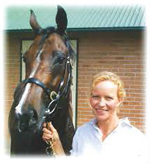 |
OTHER TOPICS available online by Dr Jennifer Stewart
Vol 41-6
PAIN IN THE JOINTS
Vol 41-5
ANAEMIA
Vol 41-4
PNEUMONIA
Vol 41- 3
POLTICE IT
Vol 41 - 2
LYME DISEASE IN AUSTRALIA
Vol 41 - 1
I CAN HEAR SAND
Vol 40 - 6
LAMENESS
Vol 40 - 4
STRESS - how do we know if our horse is stressed?
Vol 30 - 1
STIFLE LOCK
with the Equine Veterinarians Australia (EVA)
Vol 27 - 4
ROSS RIVER VIRUS
Vol 36 - 6
BIOSECURITY
Vol 31 - 5
BIG HEAD
Vol 35-6
WHAT CONTROLS APPETITE IN HORSES?
Vol 35 - 4
BEHAVIOUR OR PMS
|